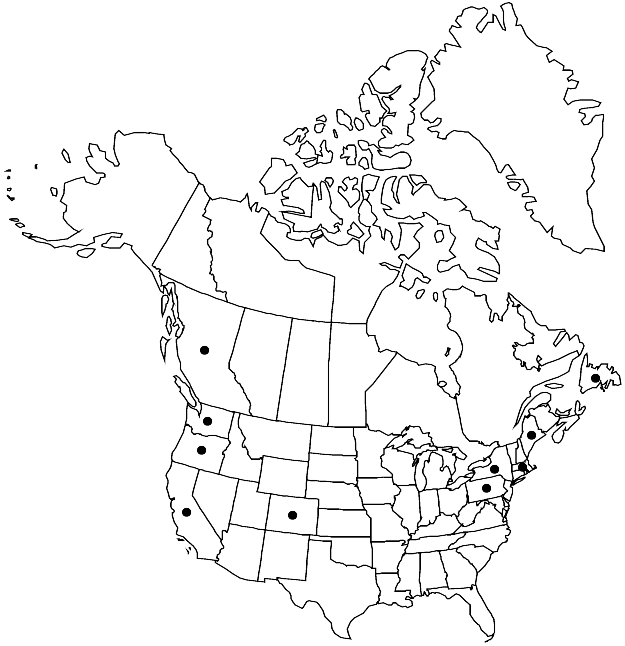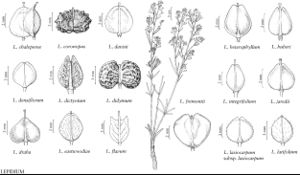Difference between revisions of "Lepidium heterophyllum"
Cat. Pl. Pyrénées, 95. 1826.
FNA>Volume Importer |
imported>Volume Importer |
||
| (3 intermediate revisions by 2 users not shown) | |||
| Line 6: | Line 6: | ||
|place=95. 1826 | |place=95. 1826 | ||
|year=1826 | |year=1826 | ||
| + | }} | ||
| + | |special_status={{Treatment/ID/Special_status | ||
| + | |code=I | ||
| + | |label=Introduced | ||
| + | }}{{Treatment/ID/Special_status | ||
| + | |code=F | ||
| + | |label=Illustrated | ||
}} | }} | ||
|basionyms= | |basionyms= | ||
| Line 23: | Line 30: | ||
|elevation=0-300 m | |elevation=0-300 m | ||
|distribution=B.C.;Nfld. and Labr. (Nfld.);Calif.;Colo.;Maine;Mass.;N.Y.;Oreg.;Pa.;Wash.;Europe. | |distribution=B.C.;Nfld. and Labr. (Nfld.);Calif.;Colo.;Maine;Mass.;N.Y.;Oreg.;Pa.;Wash.;Europe. | ||
| + | |introduced=true | ||
|discussion=<p>The records from Maine and Massachusetts are based on old collections, and it is not known if <i>Lepidium heterophyllum</i> has become established as part of the weedy flora of those states.</p> | |discussion=<p>The records from Maine and Massachusetts are based on old collections, and it is not known if <i>Lepidium heterophyllum</i> has become established as part of the weedy flora of those states.</p> | ||
|tables= | |tables= | ||
| Line 32: | Line 40: | ||
-->{{#Taxon: | -->{{#Taxon: | ||
name=Lepidium heterophyllum | name=Lepidium heterophyllum | ||
| − | |||
|authority=Bentham | |authority=Bentham | ||
|rank=species | |rank=species | ||
| Line 47: | Line 54: | ||
|publication title=Cat. Pl. Pyrénées, | |publication title=Cat. Pl. Pyrénées, | ||
|publication year=1826 | |publication year=1826 | ||
| − | |special status= | + | |special status=Introduced;Illustrated |
| − | |source xml=https:// | + | |source xml=https://bitbucket.org/aafc-mbb/fna-data-curation/src/2e0870ddd59836b60bcf96646a41e87ea5a5943a/coarse_grained_fna_xml/V7/V7_940.xml |
|tribe=Brassicaceae tribe Lepidieae | |tribe=Brassicaceae tribe Lepidieae | ||
|genus=Lepidium | |genus=Lepidium | ||
Latest revision as of 22:37, 5 November 2020
Perennials; (caudex branched); hirsute. Stems branched from base, erect to ascending, often decumbent basally, unbranched or branched (few) distally, 1–5 dm. Basal leaves rosulate; petiole 1–6.2 cm; blade oblanceolate or oblong-elliptic, 1–4.5 cm × 4–14 mm, margins entire, repand, or denticulate. Cauline leaves sessile; blade oblong to deltate-lanceolate, 1–3.5 cm × 3–8 mm, base sagittate or auriculate, margins dentate to denticulate. Racemes much-elongated in fruit; rachis hirsute, trichomes spreading, straight. Fruiting pedicels horizontal, straight or slightly recurved, (terete), 2.8–5 × 0.3–0.4 mm, hirsute. Flowers: sepals oblong, 1.6–2.2 × 0.6–1.1 mm; petals white, spatulate, 1.8–2.8 × 0.8–1.4 mm, claw 1–2 mm; stamens 6; filaments 1.8–2.6 mm, (glabrous); anthers 0.4–0.5 mm. Fruits broadly oblong to ovate, 4–5.5 × 3.5–4 mm, (curved adaxially), apically broadly winged, apical notch 0.2–0.3 mm deep; valves thin, often not papillate, not veined; style (0.6–)1–1.5 mm, well-exserted beyond apical notch. Seeds (dark brown), ovoid, 1.8–2.2 × 1–1.2 mm. 2n = 48.
Phenology: Flowering May–Jun.
Habitat: Gravel mounds, roadsides, abandoned fields, waste grounds, disturbed sites, gardens, hillsides
Elevation: 0-300 m
Distribution

Introduced; B.C., Nfld. and Labr. (Nfld.), Calif., Colo., Maine, Mass., N.Y., Oreg., Pa., Wash., Europe.
Discussion
The records from Maine and Massachusetts are based on old collections, and it is not known if Lepidium heterophyllum has become established as part of the weedy flora of those states.
Selected References
None.
